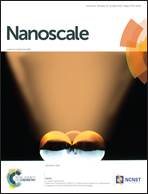Modulating the generation of long-lived charge separated states exclusively from the triplet excited states in palladium porphyrin–fullerene conjugates†
Abstract
This study demonstrates molecular engineering of a series of donor–acceptor systems to allow control of the lifetime and initial spin multiplicity of the charge-separated state. By tuning the rate of intersystem crossing (ISC) and the donor–acceptor distance, electron transfer can be made to occur exclusively from the triplet excited state of the electron donor resulting in long-lived charge separation. To achieve this, three new palladium porphyrin–fullerene donor–acceptor systems were synthesized. The heavy Pd atom enhances the rate of ISC in the porphyrin and the rates of electron and energy transfer are modulated by varying the redox potential of the porphyrin and the porphyrin–fullerene distance. In the case of the meso-tris(tolyl)porphyrinato palladium(II)-fulleropyrrolidine, the donor–acceptor distance is relatively long (13.1 Å) and the driving force for electron transfer is low. As a result, excitation of the porphyrin leads to rapid ISC followed by triplet–triplet energy transfer to fullerene. When the fullerene is bound directly to the porphyrin shortening the donor–acceptor distance to 2.6 Å electron transfer from the singlet excited palladium porphyrin leading to the generation of a short-lived charge separated state is the main process. Finally, when the palladium porphyrin is substituted with three electron rich triphenylamine entities, the lower oxidation potential of the porphyrin and appropriate donor–acceptor distance (∼13 Å), lead to electron transfer exclusively from the triplet excited state of palladium porphyrin with high quantum yield. The results show that when electron transfer occurs from the triplet state, its increased lifetime allows the distance between the donor and acceptor to be increased which results in a longer lifetime for the charge separated state.


 Please wait while we load your content...
Please wait while we load your content...